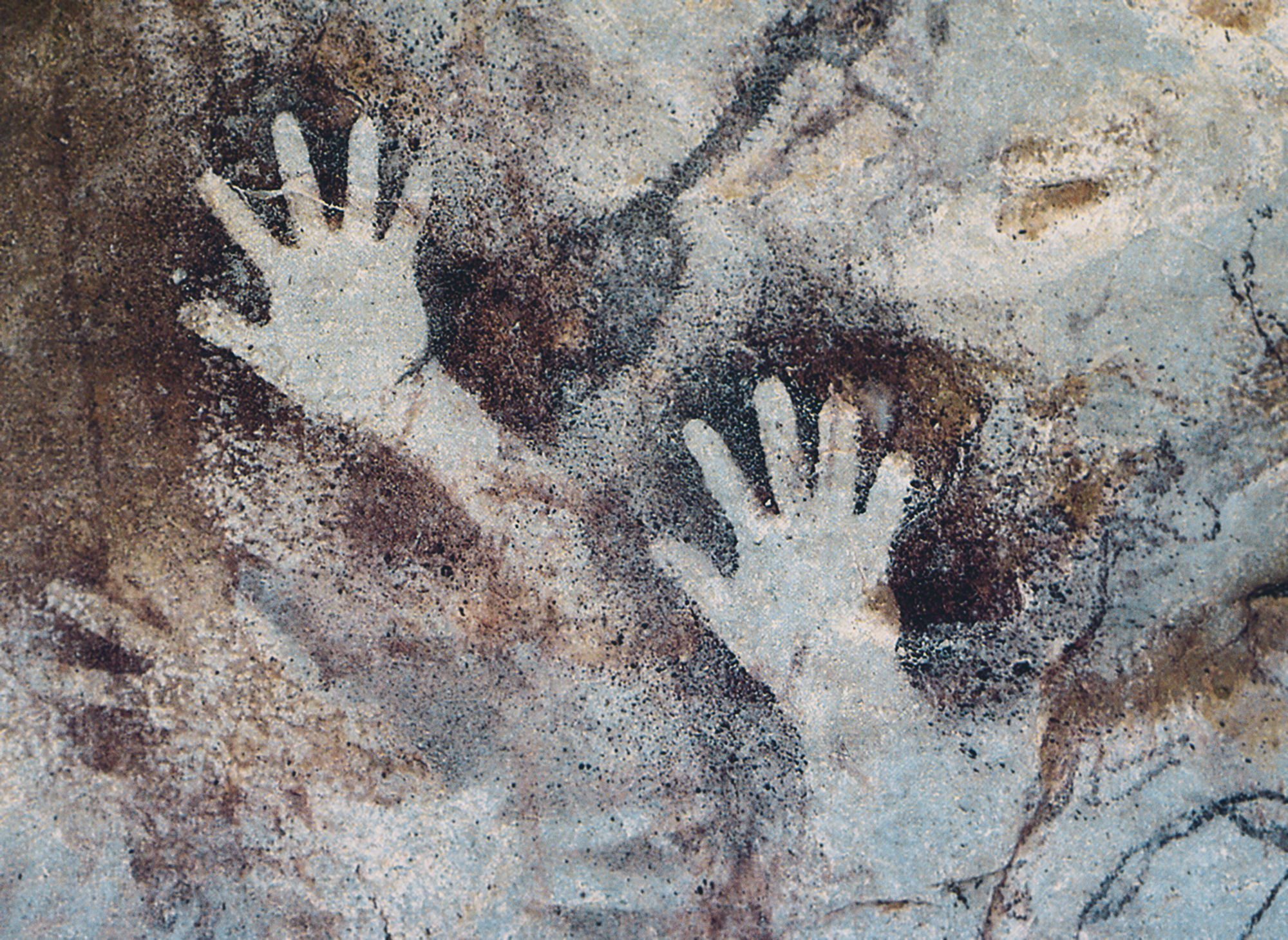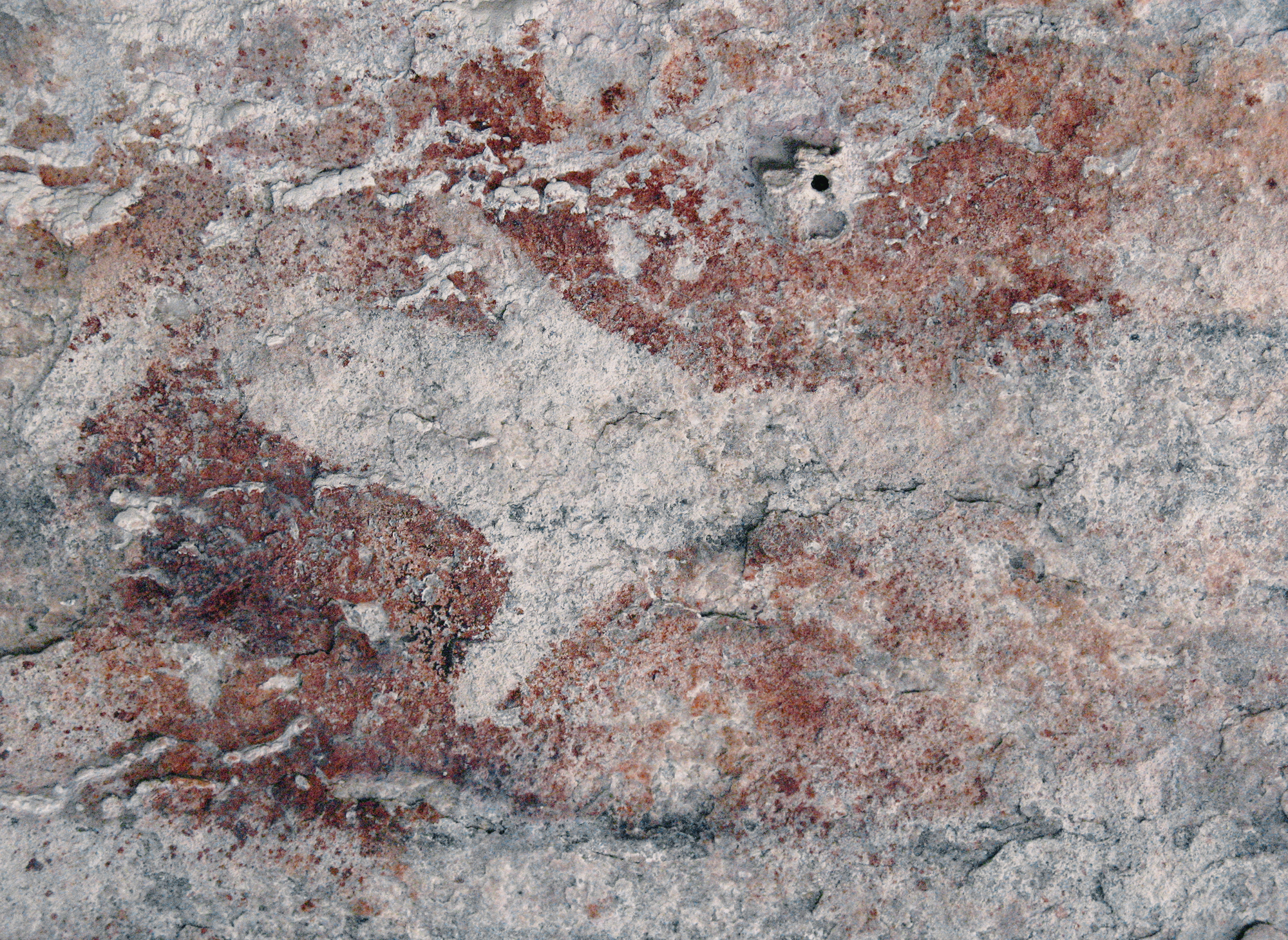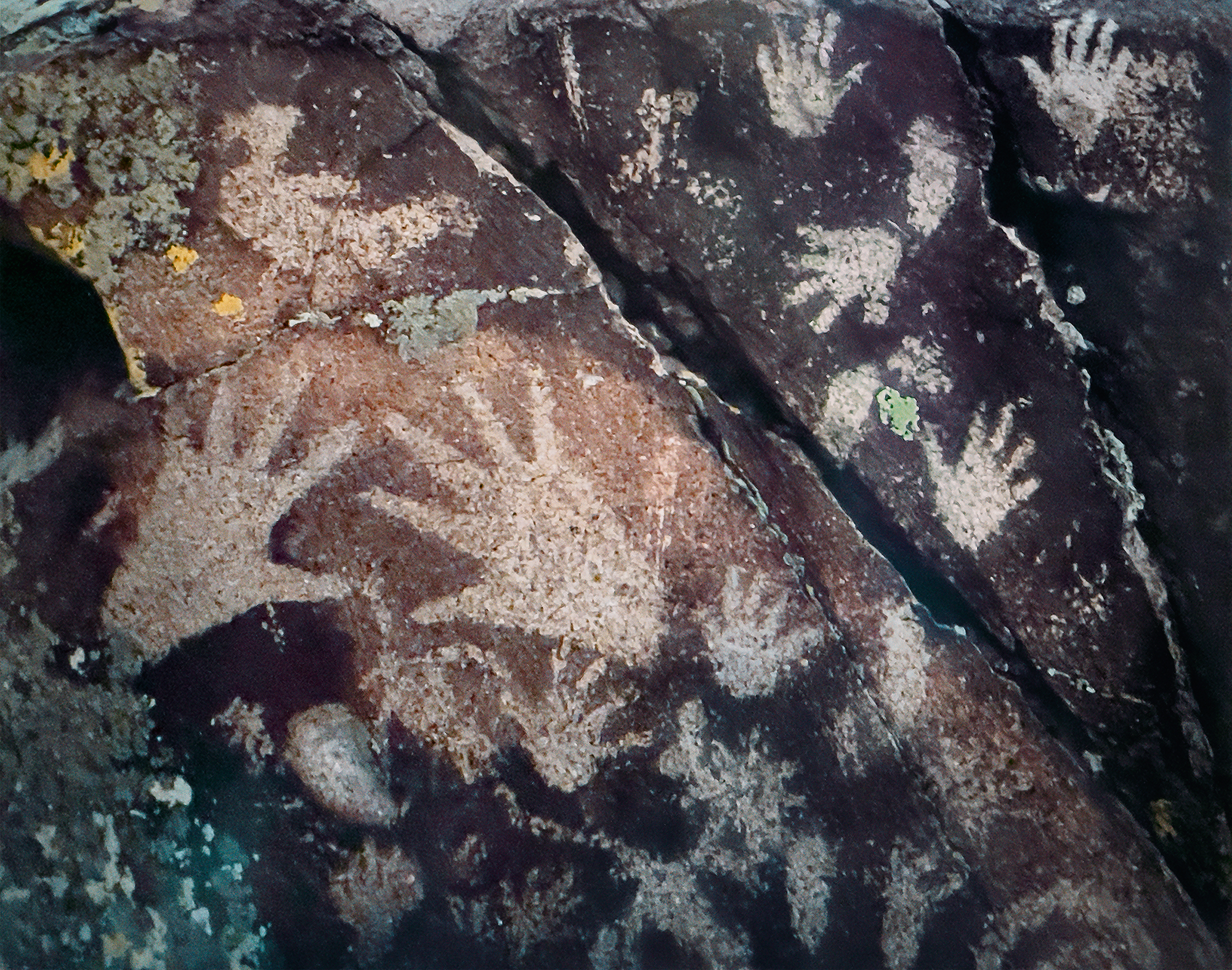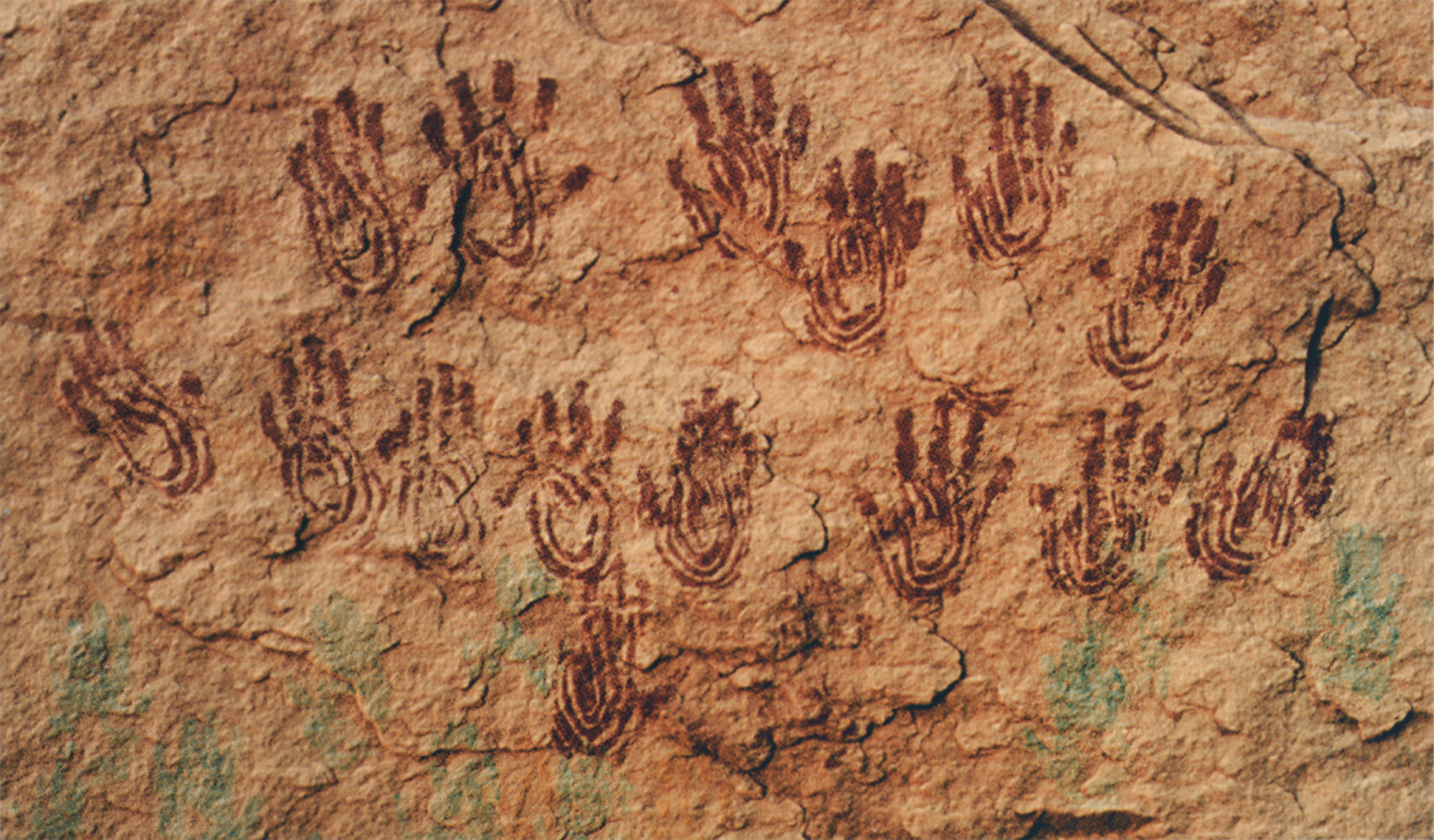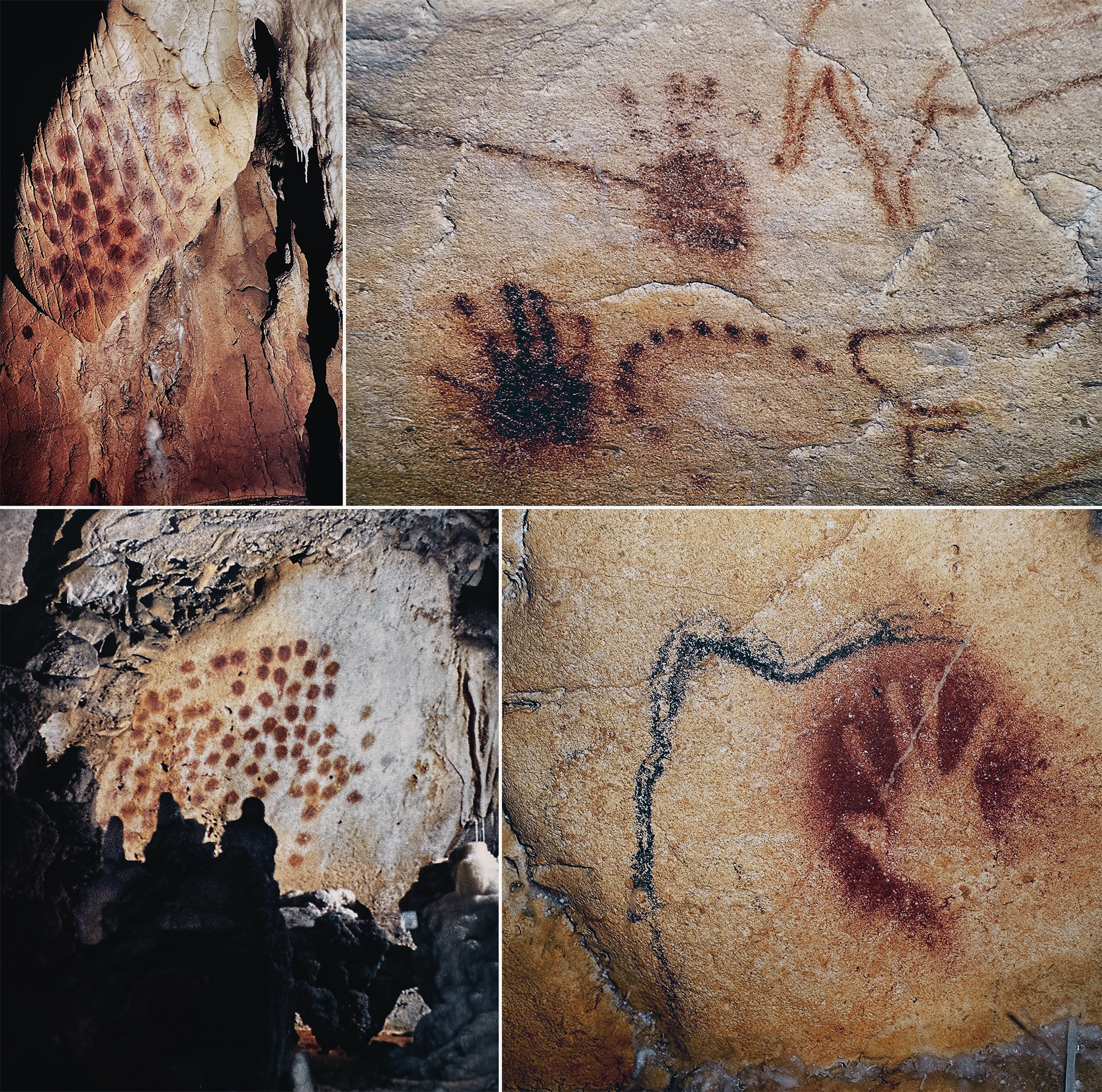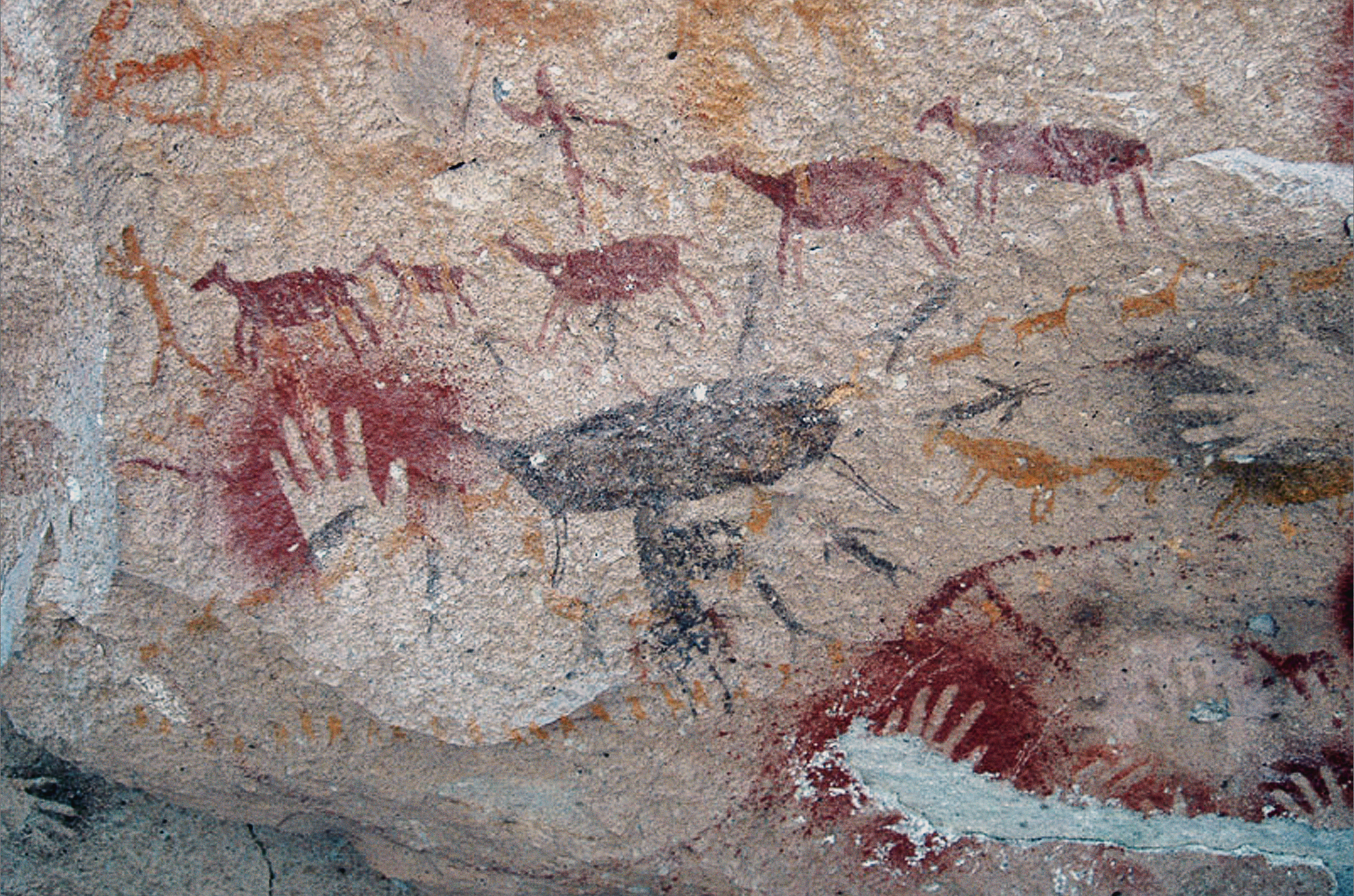




Australia is the country with most handprints or stencils in its rock art.
→ Discover more about the rock art of Australia
The image of the hand would have been created in a variety of ways: the artist may have used the hand on the rock as a stencil, spraying paint from the mouth or charcoal powder through a reed; the outline of the hand may have been painted around by brush; or simply painting the hand and then placing it on the rock. For an engraving, the hand motif may have been engraved or pecked directly on to the rock surface. Hand paintings were created by men, women and children. What ever the method, and what ever the style of accompanying art, hand paintings and engravings are one of the most common elements of rock art.
Depictions of Hands in paintings from the caves in the Maros-Pangkep karst are situated in South Sulawesi, Indonesia. The paintings from the Paleolithic considered to be the earliest figurative art in the world, dated to at least 43,900 years ago. The caves in the Maros-Pangkep karst are a cave complex, where prehistoric finds were made.[3] The whole complex is also called "Prehistoric place Leang-Leang". In a 2014 study (M. Aubert et al., "Pleistocene cave art from Sulawesi, Indonesia", Nature volume 514, pages 223–227, 9 October 2014) a hand stencil in the Leang Tempuseng cave was dated to at least 39,900 years old.
As with other parts of the world hand stencils and prints appear regularly in rock art from America. Handprints are signatures often painted with pigment, then pressed upon the rock. At other times such as with these examples of a Anasazi hand motif from the Canyon de Chelly, the hands were done intaglio with piment sprayed around the hand.
A hole naturally eroded in sandstone becomes the emergance point for a plant, which then becomes connected to a human hand. Anasazi ties to the earth seem apparent. This rock art petroglyph on a tributary to the Little Colorado River exhibits dint marks from recent reworking.
(Below) ① Rock art at featuring a hand and figures from the Village of the Great Kivas noted for its impressive array of petroglyphs and pictographs and is one of the main archeological sites illustrating the development of Zuni culture. ② More than six hundred Anasazi cliff dwellings occur in Mesa Verde National Park. Rock art, however, somewhat unusual on the high mesas. At Petroglyph Point of Chapin Mesa, an emphasis on hands, geometric shapes and stick-figure humans typifies late Anasazi artwork. ③ A great white bird looms over a pair of seated flute players with a hand motif to the right of the bird's head. The Anasazi of Canyon de Chelly frequently included turkeys and ducks in their paintings, often placing the bird above a head or actually replacing a person's head with a bird. ④ A row of hand motifs from La Trinidad in Baja California. ⑤ Rio Grande Style petroglyphs of hands and a parrot, New Mexico's Tano or Southern Tewa province. ⑥ Hand depicted in the La Cieneguilla petroglyphs. Hundreds of petroglyphs, dating from pre-contact time and the Spanish colonial era, can be found along this mesa above the Santa Fe River. Most of the petroglyphs were placed there by Keresan-speaking puebloan people living in the area between the 13th and 17th centuries.
(Source: 'Rock Art of the American Southwest' by Scott Thybony and Fred Hirschmann.)
→ Discover more about the rock art of America
And what of their meaning? Was this the signature of the artist, confirming both his or her work as well as his or her self-awareness? Was it the artist, or shaman, touching the the rock surface in order to acknowledge and therefore enter the spirit world, known as the 'sealing' ritual? Hand stencils are often found deep in caves in unlit and hard-to-reach places, requiring intention and planning, suggesting that they had some special significance. They may have been indicators of danger, orientation signs, group identity symbols or markers of hidden goods in the cave.
Sometimes a spiral is incorporated into the motif which may represent healing energy channelled through the hands as found with the ancient practice of Reiki. Given that the images exist around the world, and cover a great time span, clearly there must be a variety of meanings. The 'hand' motif could have represented any number of rituals, but without knowledgeable informants from a particular culture these cannot be proven.
Whose hands were they? Some were clearly children, judging by the size. The majority were made by adults, and most of these seem to have been women - because women's index and ring fingers tend to be more equal in length than those of men. Researchers - such as Maxime Aubert at Griffith University in Brisbane, Australia, who studies ancient cave art in Indonesia - are now looking for DNA trapped in the calcite layers that sometimes form over cave paintings. To create a stencil, a prehistoric artist would have spat paint over an outstretched hand, so their genetic material might still be present in the pigment. Being able to identify the DNA and tell whether it was a modern human or Neanderthal, a woman, man or child, one artist or many artists, will be highly illuminating.
Prehistoric hand stencils that have been reliably dated turn out to be among the earliest known artistic motifs; many are are around 40,000 years old. (A hand stencil from Maltravieso cave in Spain was found to be 66,700 years old, suggesting that a Neanderthal created it, as modern humans only arrived in Europe around 40,000 years ago. This finding has since been contested.) Paul Pettitt at Durham University explains that hand stencils were some of the first markings of a visual culture to appear - they go back a lot longer than figurative art, but acted as the inspiration for figurative art, as humans started recognising their ability to create lifelike forms in paint.
In Chauvet Cave, France, the red ochre hand prints and stencils are found in chambers throughout the cave. These were painted during the Aurignacian culture, possibly 31,000 years ago. In the Brunel Chamber, the four panels are comprised of 420 prints of palms covered with ochre. In the Red Panels Gallery, the Panel of Hand Stencils is comprised of 3 red hand stencils, 2 clusters of dots and 2 black animals - an equid and a mammoth. Two of the hand stencils sit within the outlines of the animals. In the Panel of the Red Dots, a cave painting located near the cave entrance, is composed of a cluster of large dots, which may represent a mammoth. It is perhaps one of the earliest examples of pointillism. The scientists discovered that the dots were created by covering the palm of the right hand with wet red paint and applying the hand to the wall. The consistency of the dots suggests that the painting was created by one person. The artist would have had an image in his or her mind before beginning the piece. In other words, it appears not to be a random composition.
→ Discover more about the rock art of Chauvet Cave
→ Discover more about the rock art of France
In the Gargas cave in the Pyrenees mountains of southern France, the prehistoric motifs of hands appear to represent hands that have been injured. So-called 'mutilated' hands can be seen at many other prehistoric rock art sites, but Gargas cave is the most striking example of this phenomenon (114 of the 231 hand images are missing at least one finger segment.) It has been suggested that these missing fingers are the result of accidents, frostbite or ritual mutilation, but a more likely explanation is that their creators deliberately folded away their fingers - hidden fingers under the palm of the hand - to produce specific patterns. Moreover, there are no missing fingers on any of the positive handprints in prehistoric European cave art which seems to rule out the mutilation/frostbite/accident idea.
Researchers believe that Gargas’s hand stencils reflect some kind of communication system - a Stone Age sign language. Language itself originated with hand signs as well as vocalisations, and many societies continue to use a wide range of symbolic hand gestures during hunting, storytelling and rituals alongside – and sometimes in place of – their spoken language. This could also function as a lingua franca between groups that don’t share the same spoken language.
→ Hand stencils and their missing fingers
Cuevas de las Manos, Argentina [Spanish for 'Cave of the Hands'), has an extensive panel of hand paintings made by the indigenous inhabitants (possibly forefathers of the Tehuelches) some 9,000 years ago. The hands have mainly been stencilled. Within the cave there are also depictions of human beings, guanacos, rheas, felines and other animals, as well as geometric shapes, zigzag patterns, red dots, representations of the sun, and hunting scenes. Most of the painted hands are left hands, and of a size that resembles that of a 13-year-old boy; this may have been an initiation ceremony.
→ Discover more about the rock art of Cuevas de las Manos
→ Discover more about the rock art of South America
In Borneo, Jean-Michel Chazine has been exploring the remote region of East Kalimantan, where he and his research team have discovered over 1,500 negative handprints in 30 caves. Most of them were found not in the lowest caves beside rivers but instead in the highest and most inaccessible caves. A special effort had been made, repeatedly, to create the hand paintings, possibly by a limited number of participants. Unlike the hand paintings found in the rest of the world, many in the Kalimantan caves are decorated with dots, dashes, and patterns.
In Cantabria, northern Spain, recent research in the El Castillo and La Garma caves has revealed that the hand stencil positioning within the painted caves is far from random, but responds to the shapes and fissures in the cave walls. Made under conditions of low and flickering light, scientists believe that touch - ‘palpation’ - as much as vision, would have driven and directed the locations chosen for the stencils. Under the best of lighting conditions the exploration of caves is a tactile process; hands are often placed on floors, slopes and walls to steady the body. In the extremely low light conditions that pertained for the stencillers they would be brought into very close proximity with any surface they intended to mark. Hands would be placed on surfaces, fingers and palms traced across them, and the undulations of the cave walls and ceilings could be ‘read’ as much by touch as visual inspection. (Pettitt et al 2014).
Handprints, and occasional footprints, are common in rock paintings (pictograms) throughout southern Africa but are rarely found in rock engravings (petroglyphs). The examples illustrated here come from the Western Cape Province where it is believed they were made by indigenous San hunter-gatherers from possibly as much as 4000 years ago and by Khoekhoe herders within the last 2000 years. Plain prints were made by applying mainly red ochre-based paint on the palm of the hand and pressing it against the rock. ‘Decorated’ prints, such as those at Elands Bay Cave, were made by applying paint in the same way and then removing it in a nested U pattern before pressing the palm against the rock.
In some instances, the painted fingers were dragged down the rock face to create a striped pattern (photo 3). The size of handprints measured by Anthony Manhire (1998) from a number of sites in the region suggests many may have been made by boys in the 12-14 age range and girls in the 12-16 age range.
Manhire, A. 1998. The Role of Hand Prints in the Rock Art of the South-Western Cape. South African Archaeological Bulletin 53 (168): 98-108.
→ Subscribe free to the Bradshaw Foundation YouTube Channel
→ Hand Paintings in Rock Art
→ Hand Paintings in World Rock Art
→ Cueva de las Manos | Cave of the Hands
→ The Role of Hand Prints in the Rock Art of the South-Western Cape
→ Handprints in the Rock Art & Tribal Art of Central India
→ Hand Stencils in Chhattisgarh India
→ Hand prints found in Altamira
→ Handpas Project
→ Prehistoric Hand Paintings in the Cave of Maltravieso
→ Hand stencils and their missing fingers
→ Bradshaw Foundation
→ Rock Art Network
